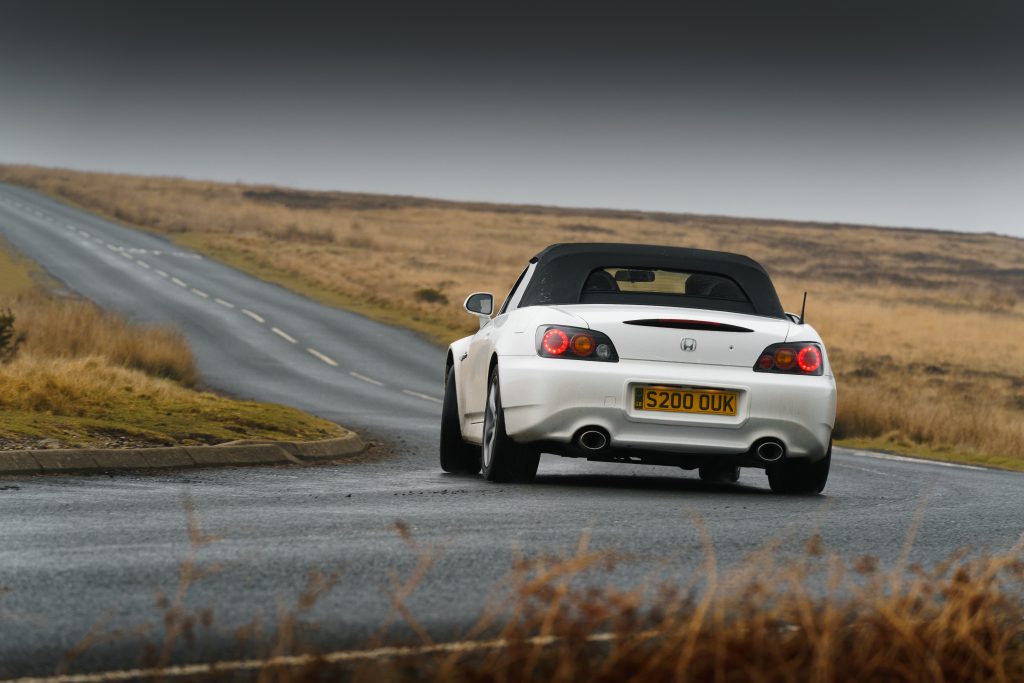Many of the greatest sports cars are defined by their engine – the Chevrolet Corvette, Jaguar E-Type, and Porsche 911 to name a few. That’s also the case with the Honda S2000, which took the company’s VTEC variable valve timing philosophy to revvy new heights. At its launch in 1999, the F20C 2.0-litre inline-four offered the highest specific power output of any naturally aspirated engine in production. With 237bhp produced at a giddy 8300rpm (on its way to a 9000rpm, redline) it behaved more like one of Honda’s motorcycle engines than one fitted into the front of a car.
That comparison with the Big H’s motorcycles is often cited when talking about the 2.0-litre engine’s modest 152lbft of torque, which trailed some way behind a Porsche Boxster’s or BMW Z4’s. This was further amplified by peak torque not arriving until 7500rpm, so the driver had to make plenty of use of the six-speed manual gearbox to get the S2000 moving as a sports car should. Yet this was all an intrinsic part of the S2000’s appeal – you had to make it sing for its supper. Luckily, both engine and gearbox are more than up to the task and can deliver 0–60mph in 6.2 seconds and 150mph all in.


Honda was unabashed about this peaky nature for its sports car’s engine. After all, it was a showcase for its tech and a birthday present to itself and the world to mark 50 years of the company. It seems amazing now to reflect that it’s another 25 years down the line since the S2000 was launched, as the two-seater drop-top still looks and feels so right. It also retains huge appeal thanks to its defiantly analogue approach to driving, where all of the decisions are up to the human in the driver’s seat and not a host of driver aids. This has also seen S2000 prices rise in recent years as more people seek out this unfiltered type of car, and as well sorted S2000s become thinner on the ground.
Honda did acknowledge the early “AP1” S2000 could be improved and added a glass window to the car’s hood in 2002. For 2004, the S2000 featured revised styling, and the steering ratio was slowed by 7 per cent to improve the car’s feeling of stability. There was a switch from 16- to 17-inch wheels, and a softer suspension set-up went a long way to addressing concerns over the car’s snappy handling. Traction control became an option in 2006 and was made standard in 2008. European S2000s stayed with the 2.0-litre engine throughout production, while US versions, dubbed “AP2,” received a 2.2-litre motor for 2004 with marginally more torque but the same 237bhp maximum power.
After 10 years and a total of 110,673 cars, Honda called time on the S2000. For the UK, there was a run-out model called the Edition 100 and all 100 of them were finished in Grand Prix White with a red leather interior and graphite-effect alloy wheels. Altogether, Honda sold 7898 S2000s in the UK, so finding a good one isn’t too hard, though it does need some due diligence.
What’s an S2000 Like to Drive?

On first acquaintance, the Honda S2000 can feel a bit ordinary and make you wonder what all the fuss is about. Next to a BMW Z4 with its lusty 3.0-litre straight-six or a Porsche Boxster with its ready punch, the Honda can seem, well, slow. Driving the S2000 requires a shift in mindset that sees you revving the engine way beyond the point where you would change up a gear in its rivals. It’s beyond 6000rpm, where the VTEC variable valve timing comes into play, that the S2000 comes alive and shows its real talents.
From 6000 to 9000rpm, the S2000 takes on a very different character from its amiable sub-6000rpm roadster manners. Suddenly, it becomes an incredibly focused sports car that demands all your attention to time the next upshift perfectly in order to keep the engine zinging. Do this all the way through the six-speed manual transmission, and there swift progress to be made. Granted, 0–60mph in 6.2 seconds is not going to worry a Porsche Boxster S in a straight line, but you’ll have a whale of a time trying in the Honda thanks to its perfect, snickety gear change. It also makes accessing the engine’s raw side quick and easy when you need to drop down a gear or three for overtaking.

Just as the throttle requires considerable input from the driver to get the best from the S2000, so do the steering and handling. The electrically assisted power steering is not as full of feel as the Boxster’s or the Mazda MX-5’s, yet it’s quick to react, so you have to learn that small, subtle movements work best to smooth the Honda into, through, and out of corners. You will also become familiar with correcting the car’s line with the steering as the rear end does move around more than you might initially expect for a relatively modern sports car. If you want a lazy cruiser, look elsewhere.
The handling of earlier S2000s drew a fair degree of criticism from owners and the press alike. While some of it was justified, the truth lay somewhere in the middle, as the S2000 was a car set up to reward finesse. The 2004 improvements to the suspension and steering made it more user friendly, so these are the ones to aim for if you intend to drive an S2000 year round or as a daily driver. However, all S2000s have excellent brakes and cope well with grizzled road surfaces, and the body, as you would expect of Honda, is impressively stiff and free from any shakes or creaks.


With the electrically operated hood raised, the cabin is decently refined for a two-seat roadster, and the hood works quickly once you’ve released the two latches and pressed the rocker switch on the transmission tunnel. A GT model came with a hard top as standard for added all-year appeal. Hood up, the cabin can feel a little claustrophobic due to the high window line and small rear window, especially if the car is trimmed in black. In other cabin colours, it avoids this, and there are plenty of details to lift the cabin ambience, such as the titanium ball for the gear lever and silver-finished rocker switches either side of the steering wheel for the stereo and air con. The aluminium-finished panel in the centre console hides the stereo, while a highlight is the digital dash with its large speedo readout. There’s also the rev counter, which arcs across the display to encourage you to use the full spread of the engine’s elasticity.



The seating position is excellent, though anyone over six feet might find the chair doesn’t push back far enough. Even so, the S2000 is comfortable for two, the boot is a reasonable size, and the build quality is beyond reproach.
How Much Does an S2000 Cost?

High-mileage, early S2000s can be found in the classifieds for as little as £7000. These cars offer an affordable route into ownership, but you will also have to budget half as much again to bring them up to a good standard. As a result, it’s more economical to look for a car from around £9500 that is already in fine condition and will have fewer miles on the dials. Cars in this price bracket will be pre-2004 AP1 versions and in daily driving shape. For a later version from 2004-on, expect to pay a further £2000 as this is what most buyers are looking for.
Very tidy examples of the earlier S2000 sit between £13,500 and £16,500, with cars at the upper end offering something you would be happy to park at a show as well as use regularly. For the very best of these pre-2004 cars, reckon on spending £23,000-plus for an immaculate version with low mileage. There’s no premium for a GT version with the hard top, which some buyers want and others don’t depending on how much they want to enjoy the car with the roof down.
With the later S2000 that benefitted from the suspension and steering improvements, between £14,000 and £18,000 gets you into an excellent car. For the very best, upwards of £24,000 will be the asking price.
What Goes Wrong and What Should You Look for When Buying an S2000?

Brace yourself for some good news: The Honda S2000 is generally very reliable, well put together, and easy to look after. There are caveats, though. Before you even go to look at any car, a history check is vital to be sure it’s not been crashed and repaired. The edgy handling of the S2000 means plenty have been spun, often with damage to bodywork, suspension, or both. Some digging should filter out those cars that have suffered more serious excursions.
Looking at a car in the metal, check for mismatched paintwork and poor panel gaps as further signs of poor repairs. Any rust on an S2000 is also a warning sign of sub-standard crash repair work, though the leading edge of the rear wheelarch is susceptible to corrosion and should be inspected closely. Don’t worry too much if the soft-top doesn’t sit completely flat when lowered as the tensioners inside the fabric weaken with age. A new hood is around £1000 for a mohair replacement, which is an upgrade on the original vinyl item.
Water in the passenger footwell is probably not due to a leaking hood but more likely the condensation drain pipe for the air conditioning has come loose and simply needs to be reattached. The rest of the cabin wears well, so it’s just the usual checks for scuffed leather seats and fully functioning electrics.


Back outside, check the wheels for any damage – not so much for the cost of refurbishing them, but for potential damage to the suspension. The S2000 is sensitive to correct suspension alignment to ensure the car handles properly, and even a slight knock from kerbing a wheel can put it out. Look for uneven wear on the tyres and the steering wheel sitting true to centre. Also check which tyres are fitted, as the S2000 is best with its original-spec Bridgestones that were developed for the car. Even if all this checks out, the Honda’s suspension can throw up some more work as the bushings are prone to seizing. Honda will sell you new ones but only complete with a whole wishbone. Luckily, upgraded aftermarket bushings are available that can be pressed into the original wishbone.
Under the bonnet, the first thing to notice is the crackle finish on the cam cover. It can flake and look scruffy, and if it’s like this it points to a disinterested owner. With the engine running, listen for any ticking that points to a worn timing chain tensioner. It’s a fairly simple fix and there are upgraded replacements that should future-proof this from ever happening again. Any rough running is most probably a failed sensor – there are ones for oxygen, air intake temperature, and manifold absolute pressure – and they are simple to replace. Corroded wiring to the ECU will be harder to spot and more costly to put right.
The gearbox and the rest of the mechanical parts of the S2000 are robust and simple to service. So, your last check is to find out how often the engine oil has been changed. The Honda can use up to a litre every 1000 miles, which is normal for this car, so be sure the owner has kept it topped up and carried out an oil service every 6000 miles or six months, whichever comes soonest. This is a high-revving motor that needs the correct oil and levels to thrive.
Which Is the Right S2000 for You?

With a decade-long production life, there is a good supply of Honda S2000s out there. This means there’s a car to suit most budgets, and we’d have no qualms about using one as an everyday driver. For that sort of use, a car in sound condition is what you’re after rather than a show-standard example. A GT version with the hard top will afford better year-round refinement, but it does mean finding somewhere to store the top safely when you want to use the car open.
When it comes to the exact specification, most buyers look to the 2004-on cars with their more supple suspension, slightly less instant steering response, and reputation for being less tail happy. That last consideration is probably the biggest factor as it imparts a psychological safety net, especially if the car has traction control fitted.
However, there is an allure to the earlier car in its slightly purer – and generally cheaper – form. This is where we’d put our money – with a clean car that has had its suspension properly serviced and aligned. And as they are Hondas, after all, if taken care of you can expect them to stick around for a very long time.











No AP2s were ever sold in Europe.
Technically the gt edition that was only sold in Europe was a ap2, even though it didn’t have the 2.2l